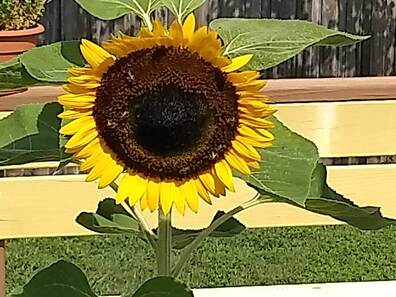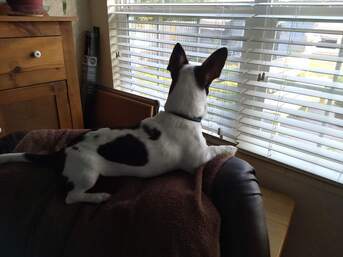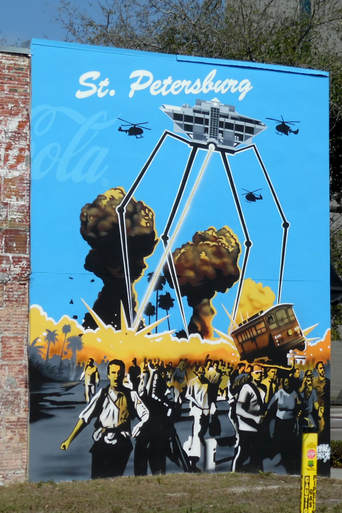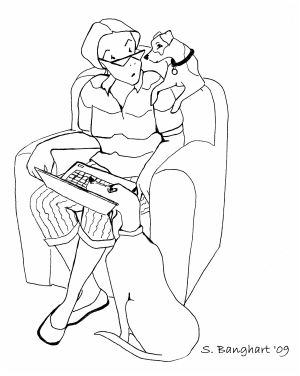 Baby birds chirp from moss-draped oaks and ducklings scurry after their mothers at the pond. Blooms explode in beds. Wildflowers pop up in yards. Butterflies and bees flit from my sunflower to Purple Queen, then travel to my neighbor's yard to sample their plumbago. I'm energized by nature, so you'd think all this new life and activity would inspire my brain to spin story. It hasn't. A couple weeks ago, I brainstormed a story with my agent and I was excited by the ideas it sparked. The story had a relatable protagonist, an intriguing premise and the potential for a satisfying outcome. The setting was moody, mysterious and a little quirky. There was a touch of magic. The magic grew and grew, and the plot took unexpected turns. As the story developed, my shoulders and neck tensed, and panic crept into my head. I asked myself why and had a revelation. I had allowed my imagination to veer too far from my life experience, and the story began to feel forced. For me to write authentic story, it needs to grow from people and experiences I relate to, and the magic needs to evolve organically. It's a valuable lesson. It helps me know myself better as a writer, and I hope it will help me write better books. But it wan't easy giving up that story. I'm restless and anxious when I'm not productively creating. I have another story started. It's growing slower than I'd like, but I'm trying to be patient. I think I'll go outside and commune with the flowers and bees. Maybe they'll buzz plot to my muse!
0 Comments
 It's Day 60 for us in quarantine. Even though we both worked from home before the Stay at Home order, things have changed. We keep running lists of supplies needed, review online orders before we send, and grocery orders the night before in case we need to add anything. We no longer shop in stores. We use drive through pick up for groceries, pharmacy and home improvement needs. In some ways, life is the same. We still walk every morning, start work at our individual desks and watch TV in the evenings. But the TV we watch is aimed at shows that uplift. And even though we care deeply about the upcoming election, we can't seem to tolerate politics. I used to enjoy the opinion section of the newspaper. Now, I skip it. I miss eating out with family and friends and I worry about restaurant workers. I miss getting to know every dog we meet on our walks. I miss taking our animals to the vet and chatting with a whole office of animal lovers. I miss meeting with artist and writer friends. I look forward to Skype visits, but it doesn't compare to the real thing. We're the first generation to drain a country of sanitizers, toilet paper and surgical masks. We're the first to experiment with a wide variety of hand sewn masks. The first generation to populate the internet with an abundant array of free entertainment and education. Artists are lifting spirits. Healers are healing, caretakers caring, teachers teaching, everyone giving what they can. The sky is clearer, animals roaming freer and the earth sighing. Today, my state lifted the Stay at Home order and began opening businesses. But we don't feel safe going out. We order more soap, sanitizer and masks, and we talk about the future with question marks.  Storm is a good word for what happens to my brain when a story erupts. I'm a fourth generation Floridian, I grew up with storms, and heard stories of hurricanes past. I love and fear them, as I do story. I love reading and creating stories and I fear I'll never do the stories in my head justice. I just finished a book and passed it to my agent. I'm letting go of the story world I've lived in for the last year, saying goodbye to the characters. Next week, my agent will submit the book to publishers, hoping to find a good fit. I've learned it's best to not waste energy on wondering if I did my best or expectations for its success. Instead, I focus on the next project. The idea for a new story came to me a while ago. I put it in a box. I lifted the lid every so often and peeked inside, but I didn't take it out of the box until last week. I listed all that I knew about the characters and their world. Then I shared it with my agent. She poked and prodded and asked lots of whys and what ifs. My husband and I walk every morning and for the last two days those whys and what ifs have fueled our steps. I walked over three miles yesterday, trying to figure out where a boy named Ash came from and why a girl named Roan was allowed in the woods. The answers to those questions lead to more questions. They twist and churn into a tornado. Soon, I hope, the beginning will pop out of that storm. It's a magical moment when the main character takes her first steps on a clean page, and she brings a steady rain of words to fill the pages after. I pray they're the right words to describe the storm in my head.  That photo is hard for me to look at because of the feelings it evokes: sadness, loss and longing. Photos do that. So can books. I recently did a workshop with screenwriter and New York Times best selling author Stephanie Storey. What struck me in her talk was the emphasis on bringing EVERYTHING when depicting emotion in a character. It's easy to capture emotion in a photo of beloved dog. In writing, it's so. Hard. To. Do. My critique group partners and I talk about this all the time. We love books because of the emotional connection, but we struggle to write emotion in depth. In a recent Society of Children's Book Writers and Illustrators Insight interview, author Stephanie Garber said that it isn't a colorful cover or favorite genre that makes us keep reading a book. It's the feelings we connect with. She believes feelings are the heart of books. Although I love novels with fantastic world building and intriguing plot, I agree with the Stephanies. What keeps me reading past midnight, what makes me slow down when I near the end, what makes me long for more pages, is my relationship with the character. I want to love a character so much, I dread every bad moment. I want to fight not to close my eyes when danger threatens. When their heart is broken, I want my tears to be unstoppable, and when they triumph, I want my heart to soar. I think most writers try to achieve this and most succeed on some level. But few accomplish a heart-stealing read. I repeatedly ask myself why. I WANT, yes with capital letters, want to write that kind of book. But how do I make that happen? Stephanie Storey goes to great lengths to explore her character's emotions. She visits museums as her character, takes online personality tests, even sees a therapist as her character. She says writers need to bring their deepest, most vulnerable feelings to the page. The part of themselves they're afraid to show to others. Those feelings are what make characters real. So easy peasy, right? Bringing everything means revisiting places in ourselves we'd rather forget. It means remembering painful moments in great detail. So, no, it isn't any more easy or fun than looking at a photo of a dog I lost at a difficult time to a pain-riddled disease. But for books that stay with readers long after they return to shelves, we must go there.  Book reviews are helpful to writers and readers. I've been a lazy reviewer in the past, so in an effort to become a more consistent reviewer, I'm hoping to post one a month. Today, I'm featuring VINCENT AND THEO, THE VAN GOGH BROTHERS by Deborah Heiligman. It won ALA's Excellence in Fiction and Printz honor awards for 2018 and I can see why. Besides books on writing craft, I don't read a lot of nonfiction. But the artist in me couldn't resist this book. It's thick (409 pages), but the chapters are short and mesmerizing and their complimented by Van Gogh's sketches and paintings. It's clear from the start, this author immersed herself in the life of these brothers. The biography is based on the enormous volume of letters Theo and Vincent exchanged. It's a tragic story, but also one of hope and endurance. Vincent's mental illness is portrayed with honesty and sensitivity, as is Theo's poor health from syphillis. Vincent's devotion to his art and the brothers' devotion to each other transcended the tragedy in their lives. When you finish this book, you'll want to set it down gently and find a quiet space to let it settle in your soul.  Mural, Dowtown, St. Petersburg, FL Mural, Dowtown, St. Petersburg, FL Writers invest a lot of time learning their craft. We study books and blogs and attend talks by authors, editors, agents and teachers, all in an effort to write better stories. We hear pretty much the same advice from everyone: Show,Don't Tell Never Open Your Book With A Dream Avoid Backstory Whenever Possible Shun Passive Verbs Balance Dialog, Action and Internality Get Rid Of Adults (for children's writers) We listen. We take their advice to heart. We work to present dramatic stories with dynamic verbs and sparse backstory. We avoid sleeping scenes with even a hint of a dream. Then apologizing to our beloved parents, we kill off the adults. We advise our critique partners to attack every instance that doesn't follow the rules and we slash the offending sections. So, it's with utter dismay that we pick up the latest award-winning novel and discover it opens with a dream and pages and pages of backstory, or the author uses to-be verbs in every other sentence, or most of the story focuses on adults. I used to frown at these books, scratch my head. Fellow writers and I would discuss the mystery. How did these books get published when they break the rules we've been taught? What I've come to understand is that great books tell a great story. Period. Readers don't know the rules and they don't care. And when it comes right down to it, neither do publishers. No doubt, they want writers to know their craft. They want them to write the best book they can with bonus points for beautiful language and style. But compelling story and voice is what sells books. When I was an art student, we were told, learn the rules, then you can break them. So that's my advice to new writers. Study, learn the rules and apply them. Practice, practice, practice. But don't ever let rules get in the way of your creativity. When you write a first draft, kick them out of your head and let the story flow. Focus on what makes your story original. Run wild with its uniqueness. Tell it the way only you can. The rules will be waiting in your handy dandy toolbox when you revise. Apply them with care, where needed. They should always make your story better. If not, put them aside.  Authors are often asked where their stories come from and they give a variety of answers: dreams, memories, an event that rattles the insides of their brains and demands to be honored, like the bombing of New York's twin towers. Kelly Barnhill, who recently won the Newbery Award with her middle grade book The Girl Who Drank the Moon, talked about the book's origins in Publisher's Weekly. She said an image of a swamp monster spouting poetry sparked the story idea. That image percolated and mixed with her interest in how people see the same thing differently, and her setting was inspired by a trip to Costa Rica. I think most stories evolve like that. A seed's planted, then another and another, growing a jungle of words in our heads. They have to get along at some point, come together in a cohesive way and they have to make us ask "what happens next? That's when our fingers start typing. The book I'm working on now started with drawings I did of fantasy figures I saw in the wood floor of an old house my husband and I were restoring. I imagined a lonely girl finding those figures and the story was born. Another book grew from a longing to commemorate the days I spent riding and training horses and the last book sprang from living in a dynamic urban neighborhood. I like to hear the main character's voice in my head before I start, but I'm not always that lucky. Sometimes, I have to write for a long while before that voice emerges. Since I'm a visual person, setting is vitally important. I need to see the world first, to understand the geography, the buildings and environment. If I try to write without that, the world doesn't feel real. My critique partners and I have discussions about describing our characters. Should we be specific, so readers have clear visuals, or should we be vague so more people can identify with the characters. I rarely know much about my character's physical description at the start of a story. For me, physicality is not nearly as important as personality. Let's not forget plot and conflict. It's what drives the story and I've learned the hard way not to start a story without knowing the protagonist's goal. If you have a story screaming to be written and you don't know the main conflict, take a deep breath, take a walk, take the time you need to figure that out. Explore issues that are important to you, like Kelly Barnhill's interest in the way people's perspectives color their world. Ask yourself how your interests and concerns might shape your character's world. Then ask what your character wants and what's the worst thing that could happen. Now, you have the start of a solid story. What are you waiting for? Start typing!  Before readers launch into a literary journey and spend hours and hours reading a story, they must be charmed or fascinated by the protagonist. It helps if the character is funny or feisty. Everyone likes feisty. Feisty faces the world with chin up and eyes blazing. Readers can't wait to see what that character gets up to and they believe whatever she faces, she'll be up to the task. It's tougher to start a story with a protagonist who's downhearted and pessimistic. In her excellent book The Magic Words: Writing Great Books for Children and Young Adults, Cheryl Klein likens the experience to listening to a negative person at a party who goes on and on about their bad luck and how it never changes. Who wants to spend time with that person? She says negative, defeated characters are unappealing. If you start a story with a protagonist who's downhearted, it's vitally important to show they're resilience and assertiveness. Immediately! And humor counts double in this story. So, guess who starts every book with a dispirited, passive person? Yep, that would be me. My muse NEVER imagines characters who wake up on the right side of the bed with a sword drawn to vanquish their enemies. In my critique group The Skyway Writers, my critique partners know I always want their eyes searching for the passages where my character lacks assertiveness. They help me see when she's reacting instead of acting, passive instead of active, finding problems instead of solutions and embracing defeat instead of believing in victory. I think most writers tend to pen protagonists with personalities that echo their own. If you're not a witty and daring optimist, that doesn't mean you can't create appealing characters. You just have to dig deeper, find the parts of you that believe in miracles and have the courage to overcome the most dreadful events. Write the character you hope to become! Do you have a story, essay, photograph or painting you'd like to share with peers across the country? Teen Ink is a magazine featuring work by teens, and only teens. You can submit throughout the year and they consider every submission for publication. They have contests for Cover Art, Fiction, Nonfiction, Poetry, Educator of the Year (you nominate your favorite teacher), Environmental, Travel and Culture and Community Service. If you're 13 -19, Teen Ink is looking for your writing and art: serious, funny, long or short, they enjoy it all. Be sure to send holiday-themed pieces months ahead of the holiday. Nonfiction winners are published each month in print and online. If your submission is accepted, you receive a free copy of the issue featuring your work and a choice of merchandise from their store. If they accept your stories or art, Teen Ink and its partners and affiliates become the owners, with the non-exclusive right to publish your work in any format, including print, electronic, and online media. That means they can reuse it today or years from today. But you retain the right to submit your work for non-exclusive publication any where and any time you wish. So, if you see another magazine or contest you'd like to submit to, you can. A word of caution: some magazines and contests only accept work that hasn't been previously published. So any time you submit your work, ask yourself if you'll be satisfied with the rewards offered. Being published in a national magazine that's available in classrooms and libraries is a pretty significant accomplishment. If you're interested in making art or writing your career, that publication credit will impress colleges and the people you hope to sell your work to. And every piece of writing or art we share with the world, makes a positive difference.  Discipline. No kidding. Yeah, the word has a rigid appearance. If it could speak, it would sound snooty and authoritative, and I doubt it's on anyone's favorite words' list. But it's a tool successful artists and writers count on to get their work done. When I was younger, I believed creativity happened when the muse struck. Like one glorious, spring day, you wake with an idea and an urge that can't be denied, and the work pours from you in an inspired frenzy. I didn't seriously wait for spring, but I did create based on urges. Then I started painting portraits for a living. Deadlines loomed. Payment depended on me producing portraits and the more I produced, the more I got paid. So, I learned to work, every day, three hours in the morning, three in the afternoon. Six hours a day is the magic formula for me. Every artist and writer is different. Author Gary Schmidt writes five hundred words a day, then he stops, no matter how excited he is by the story. Some people are most productive before dawn, some late at night. Some need music, others silence. What's important is finding what works for you and making it a habit. The only way to do that is by honoring your creative time. Put it at the top of your list and guard it fiercely. Don't let other bits of life shove it aside. I know, I know, that's hard to do. Friends are calling and texting and there's always something fun happening. But when your optimum creative window approaches, hide your phone, your iPad, your laptop. Lock yourself in a room with just you and your art. Paint. Write. Even if you're not inspired. It won't be brilliant every day and some days you'll think it's trash. But everything you produce is worth the effort. Every jot leads to the next jot. Award-winning artists and writers don't always love what they do or what they create, but they keep showing up at their desks and easels. Because they know a day will come when what they produce makes them smile from the inside out. Those are the days we live for. |
AuthorI write middle grade and young adult books with a magical twist, and I'm represented by the fabulous Leslie Zampetti at Open Book Literary. Writer Websites
Augusta Scattergood Maggie Stiefvater Rob Sanders Fred Koehler JC Kato Sarah Aronson Kelly Barnhill Linda Urban Kate DiCamillo Jacqueline Woodson Helpful Links SCBWI Agent Query Lorin Oberweger - Freelance Editor Search BlogArchives
May 2020
Categories
All
|
 RSS Feed
RSS Feed
